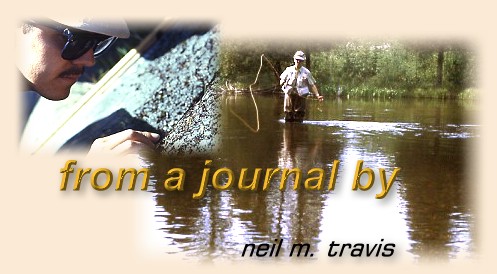Streamside Companion - Great Blue Heron
Friend or Foe?
By Neil M. Travis, Montana
Stalking gracefully through the shallows, the Great
Blue Heron is the perfect picture of composure and
concentration. Slowly lifting one foot, it inches
forward, sliding the foot back into the water without
making a ripple. Carefully it extends its long neck,
and then in a blur of motion too fast for the eye to
follow, it plunges its needle sharp beak into the
water to secure its prey. The Great Blue Heron is
truly a master at the art of stalking.
Nearly 4 feet tall, when standing fully erect, the
Great Blue Heron is the largest heron found in the
United States. Exceeded in height by only the Whooping
Crane and the Sandhill Crane, the Great Blue Heron is
the largest bird that the angler will encounter while
fishing on streams or stillwaters in the United States.
The Great Blue Heron is ideally designed to be a wading
angler. Equipped with long legs that are devoid of feathers,
the Great Blue Heron is easily able to wade in a variety
of situations. Its head culminates in a sharp beak that
is propelled forward by a long, powerful neck. Clothed in
drab colored feathers, the heron blends in with its background,
thus making it less conspicuous as it searches for its prey.
While fish compose the bulk of the Great Blue Herons diet,
they are not gourmets. Fish, frogs, snakes, crustaceans,
insects, and even small mammals are consumed with relish.
Great Blue Herons spend most of their time in aquatic
environments, however, they are sometimes encountered
hunting for prey in fields.
While the Great Blue Heron is a picture of grace in
motion when stalking prey, it is truly a majestic
picture when on the wing. Great Blue Herons fold
their long necks into a graceful S curve as they fly.
Their long legs trail out straight behind, and their
broad wings beat slowly, but steadily, as they fly
purposefully along. Great Blue Herons rarely glide,
and their flight is direct and powerful. When startled
they make a gruff croaking noise, but mostly they are
silent.
Great Blue Herons search for all their food in the
water, but for roosting and nesting purposes, they
choose trees. Most herons are colonial nesters and
gather together with others of their kind in rookeries.
These nesting colonies may consist of several hundred
birds, and the rookery may cover several acres. Great
Blue Herons appear quite at home in the trees, easily
grasping the branches with their long toes and strong
feet. They make large bulky nests of sticks in the tops
of trees, preferring isolated places, such as islands
or flooded swamps.
Some anglers express concern when they see Great Blue
Herons or other fish eating birds along their favorite
stream or stillwater. While Great Blue Herons do catch
and eat game fish such as trout, their impact on fish
numbers in a healthy fishery is minimal. The angler
can benefit from observing the tactics of a hunting
heron, and then, imitate them.
When the heron arrives at a chosen spot he will remain
still for several moments to allow the fish to resume
their normal activities. All of his movements are slow
and deliberate. When stalking a fish he wades very slowly,
lifting each foot very deliberately, being careful not
to make a splash or create a ripple that might give away
his presence. His feathers are drab colored, and he blends
into the background. A fishing heron is a picture of total
concentration and commitment to a single purpose.
Herons, like many fish eating birds and mammals, may
appear to be in competition with the angler for the
available fish. The knowledgeable angler knows and
understands that a fishery is the sum of its parts.
Over time, predator and prey have come to a mutual
appreciation and need, one for the other. Elimination
of the predators from the aquatic habitat can only have
adverse consequences, for both the fish and the angler.
The wariness that we find challenging in wild trout has
developed over eons of eluding predators like the Great
Blue Heron. Eliminate the predators, and the essential
qualities of wariness and incentive to survive them, could
make fly fishing a challenging sport which might well vanish.
In our world of ever shrinking wild places, let's learn
to cherish, enjoy, and protect what's left of our wild
heritage. As anglers, we seek out those remaining wild
places, as much for their wildness as for their trout.
The Great Blue Heron and his kin play a key role in
that setting, and the enjoyment we receive from it. ~ Neil M. Travis, Montana/Arizona
From A Journal Archives
|

